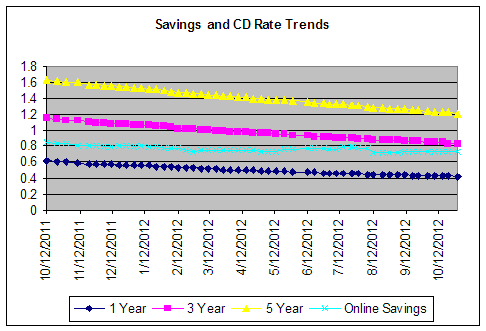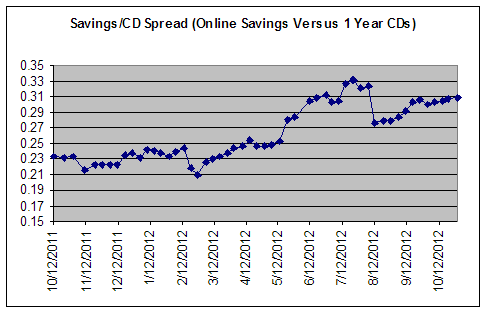Savings and CD rate averages continue to decline last week, with the one year CD average falling from .425% to .423% APY. Online savings rates from the banks offering the top 30 nationally available rates remained steady at .428% APY.

Election Impact on Savers
BestCashCow conducted a survey and received over 600 responses on various savings related questions. Regardless of who wins the election, 76% of savers say it won't have a significant impact on how they manage their money. That number drops to 60% for those over 65. Older savers may be more anxious about the election since any changes to Social Security and Medicare will have an immediate impact on their finances.
In an article entitled Low Rates Lure Yield Seekers Onto Thin Ice, economist Gary Shilling discusses the move from safe FDIC assets into riskier securities in the quest for yield. He writes in the first paragraph:
"Some investors are pursuing the safety of federally insured deposits. Others are dissatisfied with low nominal and negative real returns and are moving further out on the risk spectrum in their zeal for yield, regardless of whether they understand the additional risk they are incurring."
Our survey results shed some light on this. Despite the record low interest rates brought upon by the Great Recession and championed by the Fed, most savers appear to be keeping their money safe in the bank. Eighty-one percent of survey respondents said that record low interest rates have not pushed them to withdraw their money from the bank. In addition, a majority (53%) of respondents said that their savings and investing habits have not changed over the past four years despite scars of the financial collapse, the great recession, the increase in the Federal debt, and the persistently high unemployment rate. In fact, 74% of the 65+ respondents say they haven't made any significant changes to their savings and investment habits in the last four years. Of course, that means that 47% have changed their savings and investing habits and it's possible some have moved into riskier assets. But the record level of deposits in banks and our survey data suggests that most savers are staying put.
View more complete survey results.
Savings Options
Should a saver open a savings account or a CD? A shorter-term CD or a longer one? The chart below shows the comparison between the yield of a 5-year CD and a 1-year CD. Notice that this difference has shrunk considerably over the past year as the yield on 5-year CDs has dropped by more than the yield on a 12-month CD. This drop continued last week.

Not much has changed with the variouis product spreads. While the spread started the year at 1% or 100 basis points, it is now .790, down 3 one thousands of a point last week. As a comparison, in 2008, this spread stood at .43% while in 2010 it went as high as 1.56%. So right now, it's somewhere in the middle. Why does this matter. Because back in 2010 banks were paying a saver a lot more to invest in a 5 year CD versus a 1 year. Today, banks are giving about half the premium they did a few years ago to lock up your money for 5 years. In 2012, I advised savers to consider investing in 5-year CDs because of this premium, becasue economy looked stuck for quite some time, and because inflation did not appear to be a problem. Now, with the premium down, and the economy growing (albeit not that fast) it's a bit of a harder case to make. Consumers might want to consider laddering their CD portfolio in this rate environment.
What about the comparison between savings and CDs?

This spread has actually been growing. Online savings rates have, for the most part, maintained their rates while CD rates continue to fall. For short term savings, it appears to make more sense to park money in an online savings account versus a CD.
Interest Rates
No change from our position last week.
My take: rates will continue to drift lower for the next 12 months. After that, it's hard to tell. I suspect that rates may go up before 2015.
For now though, savers can make the best of a tough situation by getting the very best rates on their money. Remember, even in today's environment, there is competition for your cash.
I hope this is helpful. If it is, let me know and I'll keep writing. Drop me a note or post a comment below.
Have a nice weekend. Until next week...













Add your Comment
use your Google account
or use your BestCashCow account